 This information has been archived for reference or research purposes.
This information has been archived for reference or research purposes.
Archived Content
Information identified as archived on the Web is for reference, research or recordkeeping purposes. It has not been altered or updated after the date of archiving. Web pages that are archived on the Web are not subject to the Government of Canada Web Standards. As per the Communications Policy of the Government of Canada, you can request alternate formats on the "Contact Us" page.
Military History
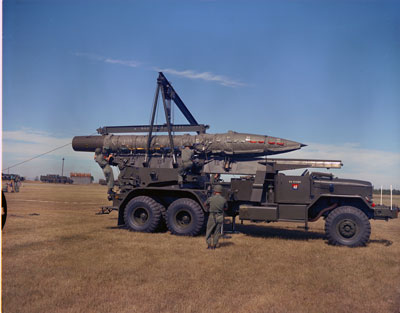
DND 536-IMG005
An Honest John nuclear artillery round mounted on its mobile transporter/launcher.
Canadian Army Tactical Nuclear Warfare Doctrine in the fifties: Force Development in the Pre-Professional Era
by Peter Kasurak
For more information on accessing this file, please visit our help page.
Introduction
The development of combat doctrine represents the highest level of corporate intellectual skills needed to manage an armed service. It requires the assessment of national goals and the derivation of required military capability. That capability must be shaped by intelligence of enemy means and intentions, knowledge of present and future technology and an appreciation of national priorities and resources to fund the force. A force must then be designed and trained to implement the doctrinal choices made by the high command. The Canadian Army that emerged from the Second World War had been reduced from 478,090 men and women to only 15,852 personnel. It had existed up to that point as a sort of branch operation of the British Army, dependent upon the head office at Horse Guards for intelligence and doctrine. By the early 1950s, it was faced with raising, deploying, and sustaining a brigade to fight in Korea, and then a second brigade to meet NATO commitments in Europe. The need to increase its size and to conduct combat operations created major management challenges, but did not require rethinking the fundamentals of combat. The advent of nuclear weapons and their adoption by the Soviet Union, however, posed just such a challenge.
While sometimes regarded as the golden age of Canadian military professionalism,1 the 1950s are more accurately seen as the beginning of a lengthy developmental phase for the army. A colonial fragment, the army struggled to stand on its own two feet. Not only was it incomplete, but it had inherited the culture of the British Army, whose concepts of leadership, staff doctrine, and organization were to contribute to its difficulty in resolving military policy challenges. The Canadian Army exited the decade much larger than when it had entered. Size, however, should not be confused with professional attainment. While the effort to develop nuclear warfare doctrine resulted in the creation of new – and hitherto missing – staff capabilities, the product itself was not a success, offering little hope of battlefield victory over Soviet opponents.
Adapting to Nuclear War
War Growing Up British
A recent study of the military effectiveness of major powers awarded the British Army a ‘D’ in tactical performance in both world wars, a ‘D’ in operational performance in the First World War, and a ‘C’ in operational performance during the inter-war period and the Second World War.2 The British Army had rejected a doctrinal approach which spelt out the details and instead issued manuals which stated only general principles. Senior officers were supposed to be able to figure things out for themselves. Bernard Montgomery commented that the army as a whole had no clear doctrine, and that when one changed one’s commander, one changed one’s doctrine.3 The British Army, therefore, could not delegate decision making and expect a standardized result. As a consequence, its style became autocratic, and it favoured attritional, set-piece battles emphasizing infantry and artillery. Armour was used as infantry support, rather than for exploitation.
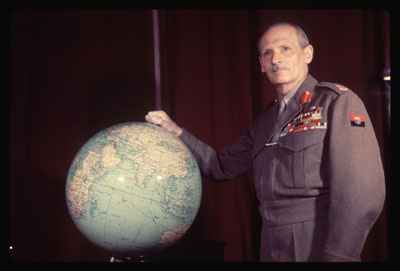
©Corbis Corporation/HU005037
Field Marshal Bernard Law Montgomery, 1st Viscount Montgomery of Alamein.
Canada relied upon the British Army for all its higher staff functions, including doctrine. All manuals and tactical training were British. And since the British Army did not regard doctrinal development as one of the fundamental functions of the staff, its staff organization (and consequently, that of Canada) had no top-level agency devoted to the development of tactical concepts for the army as a whole or for their implementation. Its British Army heritage had therefore left Canadian Army Headquarters with little or no experience in dealing with army-level development problems, a bias towards senior official personal solutions, and no staff organization focused upon army-level doctrine.
Exercise Gold Rush
The army’s first effort to adapt to the nuclear age was at the tactical level. The nuclear battlefield posed obvious problems for conventional forces and Army Headquarters recognized these first. The initial problem was how to support troops in the forward area of the nuclear battlefield. The use of nuclear weapons would require combat forces to be widely dispersed to avoid creating an attractive target. It also meant that the large numbers of ground vehicles in the logistic train presented just such a target.
Lieutenant-General Guy Simonds, the Chief of the General Staff (CGS), initiated a study in February 1955 to determine how field forces at or below the corps level should be organized, and what the logistic implications would be of future war, conventional or nuclear. This study was entitled Exercise Gold Rush.4 Simonds informed the Minister that British and American studies did not go far enough into the future, and therefore it was essential that the Canadian Army begin its own study of the problems presented to an army in the field by the new weapons of war.5 In commissioning the study, Simonds overrode concerns expressed the previous month by Major-General H.A. Sparling, the Vice-Chief of the General Staff (VCGS), who had conducted a preliminary study of the feasibility of using fixed-wing aircraft in lieu of wheeled vehicles to support combat formations in the forward area. Sparling concluded that a large number of aircraft would be required. There would be a concomitant need for continuous ground control, and also for a landing area that would require support. However, a forward air base would be difficult to protect from enemy aircraft, costly to construct, and expensive to maintain. If helicopters were used, a considerable portion of the lift would be consumed simply by moving fuel for aircraft forward. Sparling’s assessment did not deter Simonds, who thought that since the British and Americans were already researching the use of helicopters, the Canadian Army should concentrate on fixed-wing aircraft. According to him, all previous studies had been done ‘the wrong way,’ and he was not convinced there was any requirement for fixed airfields. He sought a radically different solution, in essence, ‘just in time’ air logistic support of forward combat elements.6
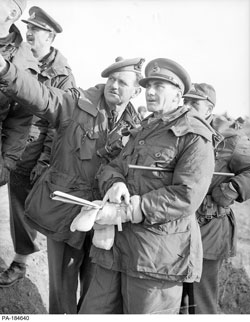
Library and Archives Canada/DND/Paul E. Tomelin/PA-184640
Lieutenant-General Guy Granville Simonds (right), and Brigadier-General John M. Rockingham, January 1952.
Gold Rush was based upon the concept of supplying infantry division and armoured brigade areas day and night by vertical-lift aircraft. An experimental helicopter unit was to be formed, and a fixed-wing ‘flying truck’ developed. The timetable was ambitious: the study phase was to be completed by December 1956 (less than two years), the helicopter experiments completed by 1957, ‘flying truck’ trials were to start the summer of 1958, and overall conclusions were to be reached by 1959. The study team was chaired by Brigadier Robert W. Moncel, the Deputy Chief of the General Staff (DCGS), and included director-level representatives of all branches, plus a Scientific Advisor. It was given a permanent staff and authority to draw upon the Army Headquarters, 1 Canadian Infantry Division and the Staff College.7
The project soon ran into difficulties. The de Havilland Company challenged the specifications for the flying truck as being beyond the state of the art. Simonds insisted upon take-off and landing capabilities within 500 feet, but existing piston engines were insufficiently powerful, turbine engines too new a development, and propeller and wing designs immature. The Defence Research Board (DRB) representatives expressed concern that industry was being pushed to produce something beyond its capabilities. Ultimately, Simonds agreed only to back off the 500 foot requirement until 1959, and to work against an interim goal of 1200 feet by 1957.8
Simonds was equally dissatisfied with the proceedings of a project working group examining tactical concepts. On receipt of their product, Simonds found that they had still concentrated troops too greatly, and that they would consequently present too compelling a nuclear target. He lectured them that he appreciated how difficult it was to divorce oneself from current concepts of war, but told them it would be necessary to make the exercise a success. He ended by virtually dictating the tactical concept to the team, including details of the distribution of armour. The working group was allowed to choose the types of guns needed.9
It was left to Simonds’ successor as CGS to complete Gold Rush. In June 1956, the study team advised Lieutenant-General H.D. Graham that the tactical concept had been presented at the divisional study period, at command and corps conferences, and was to be used as the basis for the summer’s divisional exercise at Camp Gagetown. The team recommended that the CGS approve the tactical concept as the basis for staff discussions with Britain and the United States. Graham agreed, as well as to further development.
The final concept at least partly reflected Simonds’ early direction. A battalion group covering force was to occupy a front of 10,000 yards – much greater than the 1600 yards originally proposed. The concept was that the forward zone of resistance would be set up on a major river obstacle. The covering force would detect the enemy and pressure would be exerted on the enemy during crossing so it would bunch up and present a worthwhile target for nuclear weapons. Planners expected congestion to ripple through enemy rear areas, creating additional nuclear targets. The Canadian main defensive zone would be far enough back that it would not be harmed by the initial nuclear bombardment and it would be difficult for the enemy to locate main units – perhaps 10 to 25 miles behind the main obstacle. The corps reserve would consist of mobile armoured and infantry units of regiment/battalion size supported by self-propelled artillery.
While the concept depended upon air transportability and rapid cross-country land vehicles, the ‘flying truck’ had disappeared.10 Mobility, however, remained the key to the concept, as was the reduction of the size of units. The concept called for fully tracked amphibious reconnaissance vehicles with only limited fighting capability, so that “… every opportunity to use the nuclear weapon can be taken.” Infantry were to be fully mobile in their own armoured personnel carriers, also with greater amphibious ability than those then under development. Fire support was to be provided by self-propelled weapons with nuclear shells, as well as ballistic rockets and guided missiles. Planners wanted a light anti-tank weapon effective up to tank gun range, which would probably be a guided missile. Gold Rush also called for tactical aviation and logistics aircraft for certain missions under the control of army commanders.11
Gold Rush was primarily defensive in orientation. This was a natural outcome of NATO’s strategy, British doctrinal preferences and the relatively small size of the Canadian contingent in Europe. Gold Rush included an offensive phase carried out by a massive nuclear attack on enemy air installations all the way back to Soviet main support areas.12
Graham’s opinion was that Gold Rush was sound, but he was in no hurry to implement significant force structure changes. He directed that the concepts not be used in exercises with troops, but allowed that they might be discussed with the British and Americans at an early date. Possibly with an eye on the Army budget, he noted that NATO political leaders did not think a major war was likely in the next ten years, and that thinking should therefore be focused upon post-1966 requirements.13 Following Simonds' example, he exercised his ‘divine right’ as CGS and totally redirected force development efforts. He told Major-General N.E. Rodger, the VCGS, that he would like to have studies initiated and completed within six months on the organization of an air transportable brigade group, abandoning the heavy mechanized infantry force Gold Rush had recommended. Graham further directed that the organization should be based upon ‘threes.’ That is, on three battalions of infantry with one armoured regiment of three squadrons (and perhaps a fourth for reconnaissance). Each battalion itself would be based upon three companies of three platoons of three sections each of ten men. He wanted the Gold Rush team to continue working on this project under the code name Fire-Fly.14 He then informed the Minister that he would be in a position to provide advice with respect to re-equipping the army in early 1957.15
The objective of Fire-Fly was to determine a practical air transportable field organization for the Canadian Army, to establish a date by which this might be achieved, and to develop a phase-in plan for this new structure. It stated that the roles of this force would be the rapid reinforcement of NATO in Europe; the defence of North America; and engagement in peripheral wars and police actions as part of a larger international force. It was assumed that only part of this force would be air portable in the short term, and that the balance would have to be stored overseas, or rely upon sea transport. Like the Gold Rush brigade, air transportable units were to be capable of operations with or without nuclear weapons.16
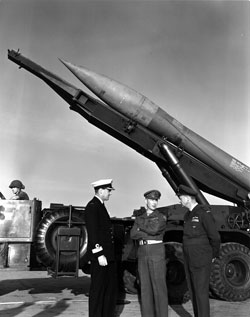
DND325-IMG0003
The tri-service officer representation in front of this Honest John is misleading.
The Gold Rush/Fire-Fly working group struggled with this new direction. The main problem was the lack of strategic airlift capability that would likely result in piecemeal commitment of forces too small to be effective. The team had doubts that any unit smaller than a division was really viable on the battlefield. They also did not know how do to logistics analysis without a commitment or operation to plan against. Throwing up their hands, they commented that provided the Canadian Army was well-trained in combined arms tactics, “… it appears that we shall have done as much as we can do.” The staff had little or no idea of the strategic airlift potential of Canada, but was pessimistic that sufficient resources existed to move anything but personnel and light equipment over modest distances. Moving armour by air was out of the question. The likelihood that no airfields would exist in the operations area meant that vertical- lift aircraft would be required. These did not exist and helicopters could not lift heavy equipment. As this situation would likely persist for some years to come, the team concluded it would be “unsound” for the army to be structured entirely as air transportable units. They were also pessimistic that Canada had the wherewithal to develop the new weapons and equipment required by the concept. Finally, the team rejected an organization based on ‘threes,’ and concluded that ‘fours’ was superior. They conceded that the British Army had adopted ‘threes,’ but claimed this was based upon “… national rather than tactical considerations.”17
Shortly after Graham received this report, he turned the entire study over to Brigadier M.P. Bogert, the Commandant of the Canadian Army Staff College at Fort Frontenac, Kingston, with the direction that by May 1957, he should advise the CGS on the types of weapons and equipment that will be available to British and American forces, on British and American tactical concepts, and on the organization up to the divisional level that would enable the application of such tactical concepts by the Canadian Army.18 And with that, Gold Rush/Fire-Fly and the army’s first attempt at thinking through a force structure for itself was officially ‘dead.’
Two exercises that had been held at Camp Gagetown in 1956 and 1957 illustrate the difficulty the army’s staff system had in developing and testing warfare concepts. The exercises were neither well-planned nor adequately assessed. Exercise Eastern Star in 1957 was expressly to test the Gold Rush concept. Army Headquarters issued an observer program directive that listed specific aspects upon which exercise staff were to report. Yet, the final exercise report contained little or nothing of a critique of the central concepts. Rather, it was a commentary on the administration of the exercise. In spite of the concepts’ dependence upon air mobility, the RCAF air liaison officer had not been included at planning conferences. Field formations and units gave little consideration to air support and did not make good use of what was available. Even then, the two helicopters assigned to the exercise could not meet minimum requirements, and two more had to be borrowed on short notice from the Royal Canadian Navy. More ominously, the exercise deliberately ignored fallout caused by the nuclear strikes, since avoiding contaminated areas would have required the exercise plan to have been changed. The post-exercise report did not draw any conclusions regarding the viability of nuclear warfare, save that the number of nuclear strikes allowed in future exercises should be severely reduced.19
The doctrinal product developed by Gold Rush/Fire-Fly was consistent with British tactical preferences in that it was both defensive and attritional, although the substitution of nuclear weapons for artillery created certain qualitative changes. It is interesting to note that the army had developed its doctrine without apparent assistance from the air arm. Both the Gold Rush and Fire-Fly concepts had huge air transport implications, but the army did not consult with the appropriate experts. While nuclear weapons greatly enlarged the battlefield, neither of the two staff studies addressed tactical aviation in any detail, except for transportation.
The process had also been too heavily driven from the top of the organization. There is a dividing line between inspired leadership and ‘pigheaded dilettantism,’ and both Simonds and Graham had crossed over that line. Given the British Army culture of “… doctrine is the opinion of the senior officer present,” and the weaknesses of the British-style staff system which did not, at the time, recognize the need for a separate, future-oriented development cell, perhaps this could only be expected.
Staff had recognized that the Gold Rush exercise was both important and qualitatively different from staff studies which had preceded it. The working group had recommended that the study team be made permanent, and, at the conclusion of the two studies, N.W. Morton, the Scientific Advisor to the CGS, recommended that a permanent planning cell was needed. Morton believed that technological development had quickened to the extent that equipment did not merely replace old types, but called into question operational concepts, organization, and logistics procedures. He thought this process was likely to be continuous in the future, and that the army faced a major risk of “gross waste” if it did not create a planning cell that could look three-to-fifteen years into the future. Morton pointed to the US Army, which already had established a combat development function at the top level of its staff.20
The Combat Development Era Begins
A more rational and systematic approach to planning the future army finally emerged in the Directorate of Combat Development (DCD), which the army established in early 1958 to institutionalize the Gold Rush staff. However, the Canadian Army did not copy the American approach of a combat development function, which was self-contained, and which drove school and exercise programs. It adopted a more modest approach which grafted the combat development cell onto the General Staff and gave it the task of “… encouraging thought, study and work on the future but not monopolizing this activity.” Its mandate made it clear that the mandate of combat development was the future of five years and more from the present. This made doctrine the preserve of existing staff organizations, primarily the Directorate of Military Training. DCD consisted only of a director and four other professional staff, plus support staff. It nevertheless developed a program of over 40 staff studies.21
Gold Rush had left behind important unresolved issues. The role of aviation has already been mentioned. The second was the lethality of tactical nuclear war. The army operations research staff continued to war game the Gold Rush concept with various levels of nuclear strike. By 1958, they had concluded that tactical nuclear warfare was impossible and that land battles as previously known would not develop. In their war games, as soon as conventional forces concentrated, a nuclear strike or two would overwhelm conventional weapons. They concluded that “… the force with no or low nuclear capability will survive but a short time and a clash between simultaneously alerted forces, both with nuclear plenty, will result in mutual annihilation.” The best that could be hoped for was that a force would endure long enough to “make a contribution to success in other theatres.”22
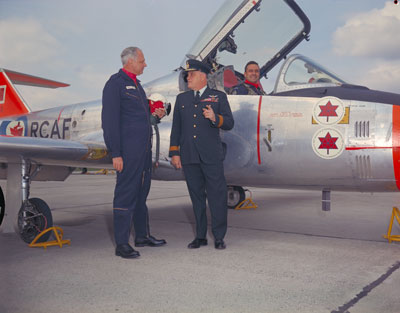
DND photo 287-IMG0025
Minister of National Defence (MND) Paul Hellyer (left) and General Jean Victor Allard in front of a brand new CT-114 Tutor jet trainer.
The army dealt with these studies by ignoring them. Major-General Jean Victor Allard, the Vice-Chief of the General Staff, merely forwarded the paper to senior officers, commenting that it contained impressions and not conclusions, and that it would be wrong to use it as the basis for new doctrine. He directed their focus to the apparent ineffectiveness of infantry in the forward zone. “They seem to be there only to become casualties.”23 However, no strategic re-thinking was undertaken, and the army remained wedded to NATO’s concept of tactical nuclear war, using the combat development process to refine it.
The third problem was equally intractable. The nuclear warfare concept the army adopted was based on small, company-sized groups fighting autonomously on a dispersed battlefield. This increased the ability to improvise at the company level, with officers requiring greater abilities at opportunism, subtlety, and deception. At the brigade level, commanders were met by ‘information overload’ by having to coordinate more units at a faster pace of decision. Neither current training nor personnel selection appeared to be geared to producing the required type of combat leader. The army’s social scientists asked, “Can the rigid authority structure of the army, designed to produce groups tailored to meet predictable situations in more or less standard ways, function flexibly enough in peacetime to develop and maintain the kind of cohesive, autonomous groups and the delegated leadership needed to ensure quick action and group survival in battle crises when the objectives may be clear, but the means confused, or clear only to the leader?” While the status quo was no longer acceptable, the social scientists believed it was “unrealistic” to expect the army to make any radical change.24
The first major product of the combat development process was The Canadian Army 1966-70 Tactical and Logistic Concept, completed in August 1961. Based upon the ABC [America – Britain – Canada] Armies Operational Concept 1966-70, the 1966-70 Concept was a comprehensive and detailed plan for the Canadian Army. It was deeply pessimistic in that it assumed that NATO forces would be facing Soviet armies just as well armed and much more numerous than the NATO defenders. Canadian society was dedicated to the dignity and preservation of the individual, and the combat developers believed that “… this type of society does not usually produce hard, rugged soldiers.” However, without any other advantage, tactical leadership was the “only real resource” remaining. The concept called for careful leadership selection, strenuous training, and ruthless elimination methods.
On the material side of the battle, the concept envisioned waves of Soviet forces driving forward, attempting to overwhelm the defenders. Anticipating the US Army’s Air/Land Battle by 20 years, the combat developers identified the need to strike deep in the enemy support zone to stop, divert, or damage reinforcements, and to blind the enemy’s target acquisition systems. Unfortunately, the provision of air support was still unresolved. Modern aircraft were regarded as too fast to allow pilots to do close air support, and the ground battle too confused to allow for adequate control. The concept therefore limited close air support to “general support tasks,” and shuffled it off for further study.25
The 1966-70 Concept represented an advance in process over its Gold Rush predecessor. It was comprehensive and more disciplined in its approach, and it was less prone to victimization by the pet ideas of senior officers. It also contained flashes of real insight regarding the importance of deep battle at the theatre level, and the need for, and advantage of, real-time information regarding the disposition of its own troops. It advocated a “tidy battlefield” made so by electronic position reporting of all vehicles.26 However, the army remained chained to Canada’s commitment to fight a nuclear war in Europe, no matter how infeasible that would have been. The problem was solved by being taken off the table. Other problems, such as close air support, could not be solved by the army because NATO air forces (including that of Canada) were not interested in maintaining suitable aircraft, and a single nation could not unilaterally alter NATO’s airpower doctrine – especially if its own air force saw no need to change it. Ultimately, the army accepted a concept that pinned its hopes upon superior leadership without a clear idea of how to achieve that superior leadership.
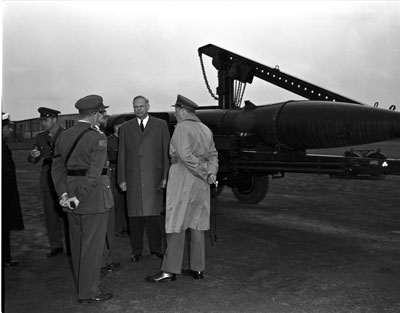
DND photo 583-IMG0061
MND Paul Hellyer with senior army officers in front of an Honest John.
Conclusion
The Canadian Army had taken a decade to develop a process to think about its future and to develop high-level institutional plans. It had left behind its total dependence upon both a mother country, and also upon individual senior leaders to do its corporate thinking for it. In the process, it had made a major advance in professionalism.
Improvements in process, however, had not solved the problems of fighting a nuclear war. The combat development staffs recognized that their model for a mechanized infantry brigade was no better than an even match for a Red Army opponent, and they had to pin a faint hope for success upon leadership and the moral superiority of Canadians. Canadian combat developers recognized the need for ‘netcentric’ operations and deep battle, but lacked the technical means and institutional support from the air force to make significant progress on either concept. The failure of the combat development process to solve the problem of nuclear warfare should have led to a strategic re-evaluation of the role of the army. Instead, concept development issues were raised and went nowhere, while the army remained chained to the central front of NATO. An attempt to integrate national strategy and the force structure of the army lay in the future with the creation of Mobile Command. Although that would also prove to be an unhappy tale, it would not be because the army lacked the capacity to develop force concepts.
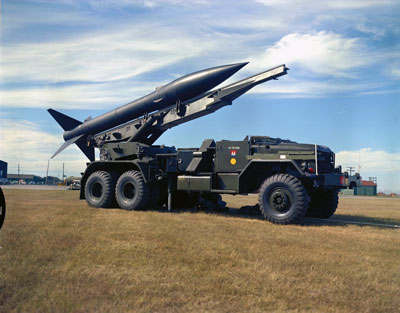
DND photo ZK-1926-2
![]()
Peter Kasurak received his PhD in diplomatic and military history from Duke University in 1976. The last two decades of a subsequent career in the Canadian Public Service were spent at the Office of the Auditor General, where he headed groups responsible for National Defence and National Security. Over the years, he has published articles on Canadian-American relations, the Canadian Army, counter-terrorism, parliamentary oversight of defence, and police governance. He occasionally teaches Defence Management and Policy at Carleton University, and is currently working on a history of the Canadian Army, 1950-2000, focusing upon its social and intellectual development.
Notes
- J.L. Granatstein, Canada’s Army: Waging War and Keeping the Peace (Toronto: University of Toronto Press, 202), p. 341.
- Lieutenant-General John H. Cushman, “Challenge and Response at the Operational and Tactical Levels, 1914-1945” in Allan R. Millett and Williamson Murray, Military Effectiveness, Volume III, The Second World War, (Boston: Unwin Hyman, 1980), pp. 320-341.
- David French, “Doctrine and Organization in the British Army, 1919-1932,” The Historical Journal, 44:2 (June 2001), pp. 514-515.
- Exercise Gold Rush, Terms of Reference for a Study of the Organization of field formations to meet conditions of future war, HQS 1200-G9 (ACS), 15 February 1955, Department of National Defence, Directorate of History and Heritage, RG 73/1299. All subsequent references to Defence archives will be cited as “DHH.”
- Simonds to MND, 14 March 1955, cited in Brief for the Chief of the General Staff, Exercise Gold Rush, HQS 2001-91/G9 (Ex GR), 12 June 1956, DHH, RG 73/1299.
- Record of a meeting held in the office of the Chief of the General Staff on Wednesday, 19 January 1955, to discuss logistic support by aircraft in the forward area, ACS/M(55)1, 21 January 1955, DHH, RG 73/1299.
- Exercise Gold Rush Terms of Reference.
- Army Council Secretariat, Record of a meeting to discuss the military characteristics of a light cargo aircraft, ACCS/M(55)5, 10 June 1955, DHH, RG 73/1299. Simonds proved to be correct in his optimism regarding performance. By 1958, the de Havilland Caribou was flying in US Army service. It could take off in zero wind within 1040 feet and within 590 feet with a 20 miles-per-hour headwind.
- Ibid. Unfortunately, the actual working papers of the various study groups are yet to be located. At this point the complete findings of the study groups and their methodology are not known. The files reviewed include primarily the CGS’s correspondence in reaction to the Gold Rush studies.
- Disappeared from the planners’ concept, but evidently not from the real world. De Havilland continued to develop the DHC-4 Caribou transport. The V/STOL Canadair CL-84 tilt-wing transport also seems to have been funded through this initiative. This aircraft first flew in 1965, and stayed in development into the early 1970s. Although prototypes were successful, it did not find a customer.
- Brief for the Chief of the General Staff, Exercise Gold Rush, HQS 2001-91/G9 (Ex GR), 12 Jun 1956, DHH, RG 73/1299; Gold Rush, Tactical Concept of Operations, n.d.[1955?], DHH, 400.0199 (D1).
- Gold-Rush Tactical Concept of Operations.
- Record of a meeting to discuss both the tactical concept and the future of Exercise Gold Rush, ACS/M (56)11, 21 June 1956, DHH, RG 73/1299.
- H.D. Graham to VCDS, 26 June 1956, DHH, RG 73/1299.
- H.D. Graham to Minister of National Defence, 26 June 1956, DHH, RG 73/1299.
- Exercise Gold Rush, HQS 2001-92/F15 (Ex GR), 3 July 1956, DHH, RG 73/1299.
- Operation Fire-Fly, HQS 2001-91/F15 (Ex GR), 28 Sep 1956, DHH, RG 73/1299.
- H.D. Graham to Brigadier M.P. Bogert, Commandant, Canadian Army Staff College, Fort Frontenac, 27 November 1956, DHH, RG 73/1299.
- Outline Observer Programme, Exercise Eastern Star, Appendix A, AHQ 2001-92/E (Trg) April 1957, DHH, 114.3Q1 (D6); Report, Exercise Eastern Star, ECS 201-91/E7 (G), 31 December 1957, DHH, 432.003 (D1).
- N.W. Morton to VCGS, Army long range planning, SA/CGS BDF13-1, 4 April 1957, DHH, RG 73/292; Canadian Army Combat Development Guide, HQS 2100-2 (DCD), 1 June 1961, DHH, RG 72/722.
- Canadian Army Combat Development Guide, HQS 2100-2 (DCD), 1 June 1961, Annex ‘A’, History of Combat Development in the Canadian Army, DHH, RG 72/722.
- Land Combat in a Nuclear War, CAORE Working Paper 58/18, DHH, RG 73/1327.
- Major-General J.V. Allard to all GOCs and Brigade Commanders, December 1958, DHH, RG 73/1327.
- Canadian Army Operations Research Establishment, Leadership Requirements Tactical Concept 1966-70, Report No. 120, July 1961, DHH, RG 81/5.
- The Canadian Army 1966-70 Tactical and Logistic Concept, Third Draft, CDY 59-2-1, HQS 2100-2-1 (DCD), 8 August 1961, DHH RG 81/616. The Concept is too voluminous to be fully discussed here. It anticipates both Air/Land Battle and ‘netcentric’ warfare.
- How this would have been achieved prior to the invention of GPS is unclear, especially since the signals part of the concept already expressed concerns about channel capacity. Nevertheless, the Concept postulated “vehicle navigation aid,” a “simple hook-up to the rear link radio set” and a display with “three dials showing a six-figure map reference.”






